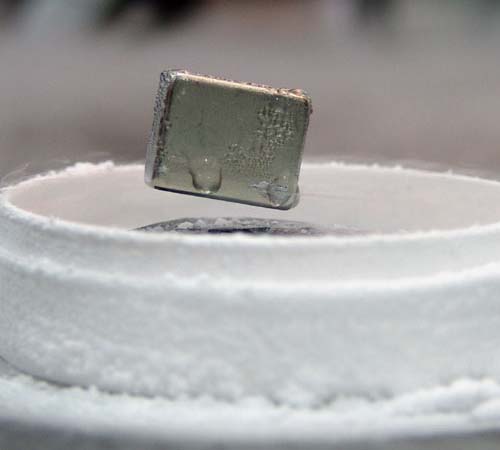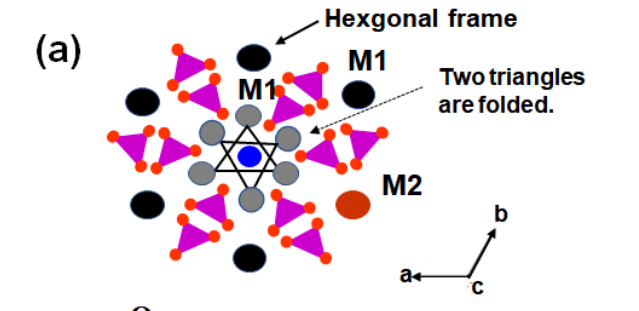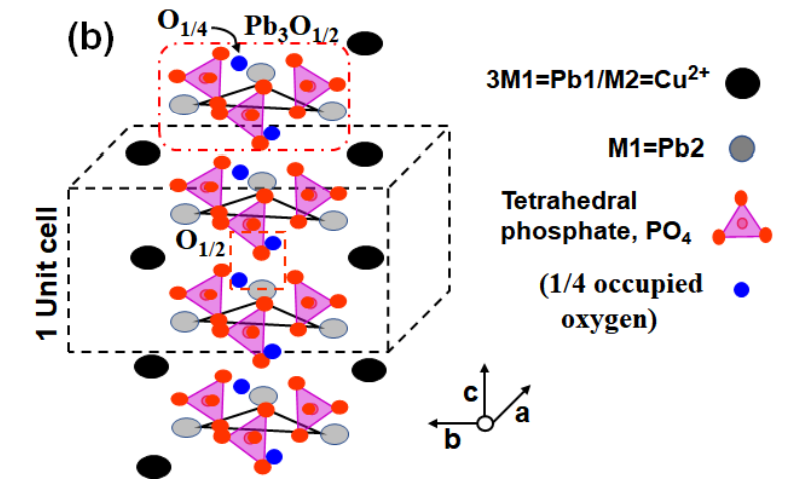

In recent days, the physics community has witnessed the emergence of research into room-temperature superconductivity. The research comes from a Korean team who uploaded two papers to arXiv, claiming to have synthesized a room-temperature superconducting material at atmospheric pressure, with a critical superconducting temperature exceeding the boiling point of water, up to 127 degrees Celsius.
The material, named LK 99, is a copper-doped lead apatite with the following chemical formula...
The synthesized sample looks like this.

Article Outline Superconductor Overview 1. What is a superconductor?2. Applications of superconductors Overview of Room Temperature Superconductivity 1. What is room temperature superconductivity? 2. Historical Process——Research on Room Temperature Superconductivity Analysis - Korean research team's superconducting synthesis method Room-temperature superconductivity controversySignificance - About Room Temperature Superconductivity |
What is a superconductor?
A superconductor is a special material with superconducting properties. Superconductivity means that under low temperature conditions, a superconductor can conduct current without resistance, and exhibits the Meissner effect, that is, a repulsive magnetic field is formed inside the superconductor in response to an external magnetic field.

Ordinary metals resist the flow of electric current or react to an applied magnetic field, causing energy to be lost as heat. Superconductors, however, completely eliminate electrical resistance at low temperatures, usually close to absolute zero, allowing electrical current to flow without any loss. This phenomenon of superconductivity results from pairings of electrons in a superconductor (called Cooper pairs), which move together rather than as individual electrons.
Applications of Superconductors
The discovery and study of superconductors is an important scientific advance with many applications in various fields, including:
1. Power transmission: Superconducting cables can greatly reduce energy loss during power transmission, thereby improving the efficiency of power transmission.
2. Magnetic resonance imaging (MRI): Superconducting magnets are used in MRI equipment to generate high-resolution medical images.
3. Magnetic levitation (maglev) train: superconducting maglev technology allows the train to run at high speed without contact on the levitation track, reducing friction and energy loss.
Quantum Computing: Superconducting qubits could be used to develop more powerful quantum computers.
However, most of today's superconductors require extremely low temperatures to exhibit superconductivity, which limits their practical applications. That's why researchers are looking for materials that can exhibit superconductivity at higher temperatures, giving rise to the concept of "room temperature superconductors".
What is Room Temperature Superconductivity?
Room temperature superconductors, also known as ambient pressure superconductors, are materials that exhibit superconductivity at more conventional temperatures and pressures, usually at or below room temperature. This is a major breakthrough because conventional superconductors require extremely low temperatures (near absolute zero) to exhibit superconductivity. If South Korea's test results are accurate, the discovery of room-temperature superconducting materials will be a major breakthrough in the field of superconductivity.
Compared with other superconductors, room-temperature superconductors can operate under conditions that are more easily achievable in everyday life.

In 2020, the highest temperature superconductivity was obtained in a system containing carbon and hydrogen sulfide under ultra-high pressure, with a pressure of 267 GPa and a critical temperature of +15 °C.
Historical Process——Research on Room Temperature Superconductivity
For the research of the Korean team, many people can't believe it. Caution must be exercised until results are reproduced. The road to room-temperature superconductivity has been long, dating back to the early 20th century.
In 1911, Dutch physicist Heike Kamerlingh Onnes first discovered superconductivity in a mercury filament cooled to 4.2 K (-269°C).
In 1957, physicists John Bardeen, Leon Cooper, and Robert Schrieffer theoretically explained this phenomenon with their "BCS theory," showed that electrons compressed through a superconductor temporarily distort the material's structure, causing electron exchange.
In 1986, physicists discovered that copper oxide ceramics exhibit superconductivity at a higher critical temperature Tc=30 K (about -243°C).
In 1994, researchers raised the critical temperature (Tc) of mercury-based copper oxide under pressure to 164 K (about -109°C). However, the mechanism behind the superconductivity of cuprate superconductors remains unknown.
In the 21st century, many researchers have made efforts in this field and achieved outstanding results. Ranga Dias, a physicist at the University of Rochester, is one of them.
In 2020, the Dias team published a cover story in the journal Nature, claiming to have achieved superconductivity in the carbon sulfhydryl (CSH) system at 267 GPa and 287 K (about 15 degrees), marking the first realization of high pressure and superconductivity. guide. in room temperature.
Unfortunately, in September 2022, Nature announced the retraction of the article. That didn't stop Dias, however, and the physics world had another major breakthrough the following March.
At the March annual meeting of the American Physical Society in Las Vegas, Ranga Dias announced the invention of a superconductor that works at room temperature and near atmospheric pressure. Composed of hydrogen, nitrogen, and the rare earth metal lutetium, the superconductor successfully conducts electrical current without resistance at 21°C (294 K) and a pressure of about 1 GPa. The study was also published in the journal Nature.
Analysis - Korean research team's superconducting synthesis method
The synthesis method of the room temperature superconducting material LK 99 by the South Korean research team was analyzed by well-known science experts. The material is copper-doped lead apatite with a copper doping parameter x of about 0.9 to 1.1.
The synthesis process consists of three steps:

1. Synthesis of chalcopyrite: Mix lead oxide and lead sulfate powder and heat at 725°C for 24 hours in the presence of air to generate chalcopyrite.
2. Synthesis of copper phosphide crystals: Mix copper and phosphorus powders and seal them in a vacuum tube, then heat at 550°C for 48 hours to form copper phosphide crystals.
3. Synthesis of final material: Chalcopyrite and copper phosphide crystals were ground into powder, mixed and sealed in a vacuum tube. The sealed tube is then heated at 925°C for 5-20 hours to transform into the final superconducting material. During this process, the elemental sulfur in the lead sulfate evaporates.
The picture shows the photos of the third step: e is the mixed powder before the reaction, f is the sealed sample after the reaction, g is the appearance of the sample when it is taken out, and h and i are the photos of the obtained sample.
The synthesized material has a hexagonal crystal structure and belongs to the hexagonal crystal system. In the superconducting state, the sample forms a one-dimensional superconducting chain along the c-axis direction.

The authors measured the resistance of the samples using the four-probe method and observed a significant jump in resistance around 105 degrees Celsius, indicating a transition to superconductivity. However, the resistance does not immediately drop to zero, which is expected since not all electrons participate in Cooper pairing at finite temperatures.
Diamagnetism, specifically the Meissner effect, was also observed in the samples, providing further evidence for superconductivity. The critical current, critical magnetic field and critical temperature of the sample were measured, and it was found that the critical temperature was as high as 400 Kelvin or 127 degrees Celsius.

The theoretical explanation for the high critical temperature involves the formation of one-dimensional or nearly one-dimensional metals due to the strong correlation between copper doping and electrons.
They used the four-probe method to measure the resistance of sample 2 at a current of 30 mA, and found that there was a significant jump in resistance at around 105 degrees Celsius, and they estimated that a superconducting transition occurred at this time.
However, instead of jumping directly to 0, the resistance jumps to a relatively low value first. After entering a lower temperature, below about 60 degrees Celsius, the resistance is almost zero. "Professor He Xingxing" explained that in reality, after a superconductor enters a superconducting state, the resistance is not necessarily strictly zero. This is because not all electrons have to participate in Cooper pairing at a finite temperature, and unpaired electrons can still contribute to resistance, especially in the region near the critical temperature. The author of the article concluded from the resistance measurement results that the superconductor is an S-type superconductor (see the popular science video "Professor He of the Stars" for a detailed explanation).

The article's work analysis concluded that the synthesis method and experimental proof have been completed, and other research groups should follow up and verify these results as soon as possible, because the experiment does not require a high-pressure environment, making it less difficult than previous experiments.
Room-temperature superconductivity controversy
In 2020, the superconductor that reached the highest temperature was obtained in a system containing carbon and hydrogen sulfide at ultra-high pressure, with a pressure of 267 GPa and a critical temperature of +15 °C. The highest temperature superconductor at atmospheric pressure is the cuprate-based high-temperature superconductor, which exhibits superconductivity at a temperature of 138 K (-135 °C).
The conditions required to achieve room temperature superconductivity are extremely stringent, and the current conditions only allow superconductivity at extremely high pressure or extremely low temperature, not to mention its high cost and limited application in operating scenarios.
If there is a material that can achieve superconductivity at room temperature and pressure and is relatively easy to obtain, its appearance may mark the beginning of a new industrial revolution. Its applications include the large-scale application of magnetic fields, the manipulation of materials without contact (such as controlling nuclear fusion), the transmission of electric current without energy, ultra-long-distance communication, new forms, etc. Energy, etc., has revolutionized almost everything that relies on electricity to run. This may have once been the stuff of science fiction.
Significance - About Room Temperature Superconductivity
Taking the most common power-related products as an example, non-resistive superconductors will completely solve the problem of energy loss due to resistance. Superconducting computers would eliminate the need for heat dissipation, make them thinner, and run much faster. Household energy consumption will be greatly reduced, and electric vehicles will completely replace fuel vehicles.
In the power generation and transmission industry, many petroleum-powered equipment, such as diesel and gasoline engines, will be replaced by superconducting motors, revolutionizing industries such as petroleum, chemical, aerospace and metallurgy. At the same time, superconducting wires and transformers made of superconducting materials can transmit electricity almost without loss, thereby solving the problem of power shortage.
In addition, the emergence of superconducting materials may drive the development of high-speed maglev trains, and maglev rail transit can be implemented on a large scale.
In a more sci-fi scenario, controlled fusion technology could become a reality. The scene depicted in "The Three-Body Problem" may become a reality, allowing humans to fly into the universe and rewrite human history.
At present, the problem of room temperature and pressure superconducting materials has become a hot topic. Since the reproduction of the results is relatively simple, many teams at home and abroad are probably working tirelessly to reproduce the experimental results.
Taken together, simply proving that room-temperature superconductivity is possible is an important step forward. We eagerly await new historical processes and discoveries that may change the world.
For more than a decade, EBYTE has been at the forefront of the development of long-range broadband communication technologies for the deployment of private wireless networks. Relying on the advantages of wireless communication technology, many industrial problems have been solved, and industrial solutions for the Internet of Things based on wireless technology have been derived.








